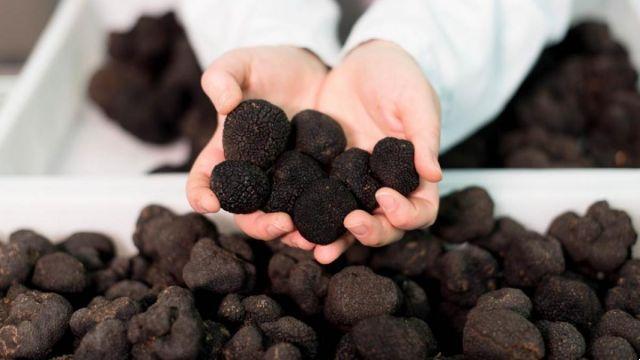
What are the fragrant truffles? They are none other than un genus of mushrooms (the Genus Tuber) which produce their fruit underground.
The normal mushrooms we know and buy are in fact only the fruit of the whole organism, which the mycelium (the hypogeal part) ejects to emit the spores.
In the case of the truffle, everything happens underground, in symbiotic relationship with specific trees (mainly oak and holm oak).
Not producing an apogee fruit, the truffle attracts men and animals with its strong and persistent aroma so that it is unearthed and then helped to propagate the spores.
As it is known, it can reach exorbitant prices, beyond the reach of ordinary consumers (up to more than 3000 per kg for valuable species), it is no coincidence that it is called "the diamond of the kitchen”: It is officially considered the most expensive food in the world.
Properties and benefits
What's beyond the unmistakable aroma and stellar price? It seems that the truffle, in its various species, aid digestion and is able, with its wide range of aromatic oils, to produce strongly antioxidant and elasticising effects of the tissues.
It's a'excellent source of magnesium and calcium, with a low fat content and a very high protein content, much higher than that of meat, given its low level of water, and we are talking about noble proteins, of excellent quality.
Except the Vitamin C with its antioxidant effects, the truffle is poor in vitamins, while its range of minerals is quite extensive. It seems that it is not only rumors or urban legends that they attribute to the truffle aphrodisiac properties: it seems that it contains various substances (specifically fatty acids) common to other foods considered aphrodisiacs.
Even if the nickname "natural viagra"Is exaggerated and inappropriate, it would seem that the truffle can help increase desire. A little more serious studies have shown that the substances contained in some species of truffles are capable of counteract some turmoral forms thanks to their strong antioxidant powers.
It seems they are able to lower the level of cytotoxicity of some carcinogenic substances, to prevent the oxidation of iron and, above all, induce the production of a hormone important in the prevention of brain cancer and breast cancer.
It seems that thetruffle oil, the real one and not chemically counterfeit, is an excellent remedy in this sense: cheaper versions can be found produced with truffles from the Mediterranean desert areas (especially from Morocco), although the one produced with el paeseni and French truffles remains the best.
Read also Truffle, precious autumn food >>
Where to find it
Let's talk about the origins of the truffle. The best truffles in the world come from the country, followed by France: Piedmont, Umbria, Tuscany, Campania lead the list of the richest regions. As mentioned, truffles grow in symbiosis with specific tree species, and yet in soils that are not excessively rich in humus, but rather calcareous.
Some animal species are greedy and sensitive to the scent of the truffle even when this is underground: trained dogs and pigs, which man makes use of, but also badgers, wild boars, mice, porcupines, roe deer and foxes. Unlike the dog, which if properly trained will not eat truffles, the pig loves it and is difficult to control.
To go for truffles it is necessary to follow courses, in order not to waste energy, money and time, and to learn the methods of research and collection. It is essential to have a dog and train it. Much easier, but extremely expensive, is to show up at a festival, a festival or a bag of truffles and hope to find something at a good price.
Read also Autumn mushrooms: how to recognize them >>


























